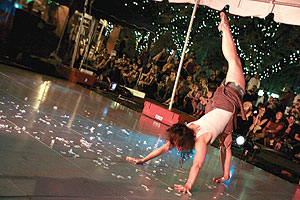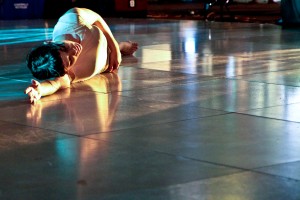
The Somerville Dance Fest dazzled audiences in Union Square last week.
– Photo by Kristophe Diaz
By Tatiana Kombo
In conjunction with the Somerville Arts Council, Zoe Dance, a local dance and performance company, presented Somerville Dance Fest, a free outdoor festival in Union Square on Friday, July 27. The event featured a dozen dance groups that ranged in style from dance theater and step to improvisation.
The common thread between the presentations was video projection, which was utilized by all of the groups. Callie Chapman Korn of Zoe Dance said, “Somerville Dance Fest came out of the idea of getting people to see dance, and not just any dance; dance with some production value.” She further explains that the video projection, in Zoe Dance’s case a webcam, captured the dancers’ movements, “adding a delay” before “feeding it back out to the projector.” The process created an illusion of the dancers partaking in the choreography with themselves, or “whoever they were 10, 20, 30 seconds ago.”
Aside from the technical aspects of the production, Callie Chapman says that she is “completely overwhelmed by the dedication, hard work and care the participants of the festival have given this event.” Indeed, the response of local choreographers was extremely promising, even when the project was budding, and prior to the Somerville Arts Council’s involvement.
From this positive reaction, Chapman concludes something that she already knew, which is that dancers and choreographers “just want to dance” and to “present their work.” Insisting on the benefits of community performances, Chapman notes that “dance can be insular,” and that people do not necessarily “give dance a chance.” Instead, she believes that dance is a powerful tool that can “stir some emotion or visceral feeling that you wouldn’t necessarily get in a rock concert or a poetry reading.” She adds that dance performances can be “intellectual” and “raw.” Most importantly, they use “the human body to communicate something.” Further, she wonders “why this doesn’t happen more often,” suggesting that “we band together and create space to present our work in a public space where one may catch the eye of a passerby and affect them in some way.”

– Photo by Kristophe Diaz.
This idea is reminiscent of Zoe Dance’s goal, to “educate the public and create social awareness through themes explored in repertory.” In reference to current economically difficult times, Chapman states that “ artists are so creative, they can make something wonderful without any money at all,” going on to say that performing on a tight budget “may not be easy or profitable or just or humane, but it has to happen to keep art in the communities and have it in the lives of people living there.” According to Chapman, the resources that were pulled with a grant of $1200, a small additional sponsorship, the Somerville Arts Council and Chapman herself, in her role of producer “were pretty amazing.”
This year, the Somerville Dance Fest went on despite the threat of rain. Chapman notes that in attendance were “a wonderful crowd of people including children, dance audience, friends, family and strangers.” The production moved from a few of community groups including Jody Weber’s community dancers, to hip hop with ITM dance, and continued throughout the evening with performances “from Dois Apsaras, Alicia Cristofi-Walshe, Jimena Bermejo-Black and Alli Ross, Contrapose Dance, Marcia Rotondo, Kelley Donovan, Zoe Dance, CHIMERAlab and Luminarium Dance.” The latter finished the program with an excerpt of their production, Mythos : Pathos, which will be presented fully at Somerville’s Armory this weekend.
Chapman believes that “it was a festival that showed the audience where dance was at in their community.” She wonders why people are “missing the opportunity to be with each other and read the body language of another in public space,” instead of “delving into their iPods,” which is, in her opinion, similar to putting oneself “in a sensory bubble” whilst traveling around. Chapman urges everyone to “focus on communication.”
In her concluding remarks, she notes that dancers “have a sense of visceral responsibility for one another,” noting that they know “what the other is going to do without even looking,” which takes “training,” “awareness,” and “compassion and openness.”
Without choreographers and dancers performing and presenting their own work, Chapman believes that “we would just be in studios creating with no place to show what we work so hard for,” further noting that “the community would not know they need us,” even if “they experience ‘it’ while they are trying to catch their bus.”















Reader Comments